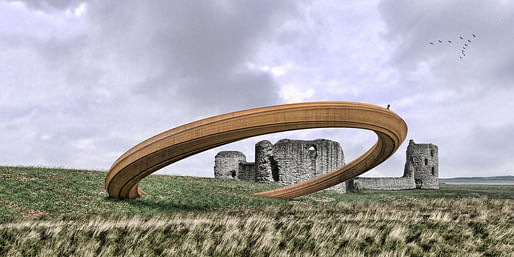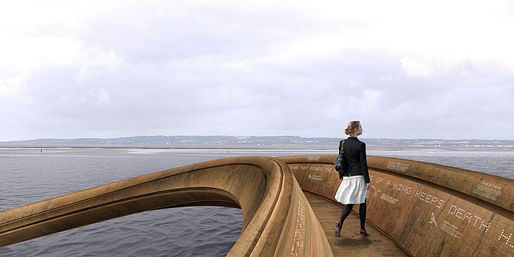
Located in Flint, Flintshire, Flint Castle was the first of a series of castles that formed a chain of fortresses known as Edward I's "Iron Ring." As part of the King's campaign to conquer Wales, the castle was built in local Millstone Grit ashlar and sandstone by 1,800 laborers and masons. The site has stood for over 700 years and today is managed as a public monument.
In an effort to rejuvenate the town of Flint and draw in tourists, the city has been working towards a multi-million pound regeneration plan that includes transforming the castle into a key site for tourism. Part of this transformation includes the installation of a stainless-steel spiral staircase and other improvements, but the most expensive will be the addition of a £400,000 landmark sculpture, the plans for which were unveiled yesterday.

Following a nation-wide competition to obtain proposals for an artwork concept celebrating Wales’ Year of Legends, the panel—comprised of the Welsh Government and sponsored body, Arts Council for Wales—has selected the winning design. Submitted by George King Architects, the design is for a giant iron ring meant to reference the chain of castles Flint belongs to as well as, more symbolically, the crown. George King, one of the architects behind the ambitious design, said "the sculpture will take a balanced form, some buried beneath the ground, the remainder projecting into the air, to demonstrate the unstable nature of the crown." As described in Shakespeare's Richard II, Flint is the site where Richard II famously surrendered the crown to Henry IV.

The sculpture will potentially stand at 23 feet high and 98 feet wide and is designed as a cantilevered bridge structure formed from weathering steel. Visitors will be able to walk along the bridge, which will be engraved with words and sayings chosen by the community that celebrate local landmarks, historic towns, and their links with Flint Castle. "The sculpture has been carefully designed to work at many scales. From afar its striking, iconic form resembles a giant ancient artifact, washed up on the shore of the Dee Estuary" King said. “Its scale and dynamic appearance means that it will become an instantly recognizable landmark for the area. However, as you approach the sculpture it becomes obvious that the piece is more than just a sculpture.”

Kinderspace: Architecture for Children's Development #2
Register by Thu, Jan 16, 2025
Submit by Mon, Jun 16, 2025

250,000 € Prize / HOUSE OF THE FUTURE 2024/25
Register by Wed, Apr 30, 2025
Submit by Mon, Jun 2, 2025

The Architect's Chair / Edition #3
Register by Wed, Jan 15, 2025
Submit by Tue, Feb 18, 2025

Museum of Emotions / Edition #6
Register by Thu, Jan 23, 2025
Submit by Tue, Apr 29, 2025
13 Comments
Absolutely! Us taffs should quite rightly celebrate and be eternally grateful for the fact that we were conquered and subjugated by the English who tried to wipe out our language and culture off the face of the planet and make us English.
Ie wir! A byddwch r?an, er mwyn denu mwy o dwristiaid i Jersey, yn dylunio cerflun neis, del, artistig ar lun swastika? Dwi ddim yn meddwl felly! Mae haerllugrwydd y Sais wrth ein trin ni'r Cymry a'n hanes a'n diwylliant lawn mor fyw ag erioed. Mae'n bryd i chi ddechrau dysgu i'n parchu.
Hurrah! Let's celebrate the conquest of Wales. Edward cut off the head of the last Prince of Wales, Llywelyn in 1282, placed it on a pole in London for all to mock. A revolt in 1283 was quashed.
The castles were built to keep down the natives and a system of apartheid was instigated which ruled where Welsh people could live and do commerce. The castles of Wales weren't build as cuddly or post-modern tourist attractions, they were build as Israelis or apartheid South Africa build watch towers and forts.
And please, don't give us the glib 'European monarchs'.
This scultpure should never be built.
Would the English celebrate (and that's what is is) Napoleon or Hitler's 'ring of steel' castles had history turned out differently?
I'm all for regenerating Flint and drawing people to the castle. But I'm fed up seeing Welsh government bodies with people on good salaries and perks celebrate the subjection of Wales whilst refusing to fund a sculture for Tryweryn by John Meirion Morris, or Glyndwr's Sycharth. And this constant apprisal of Welsh history through the norms of English historiography - that is, it's only important if it relates to England. Welsh history and historical landmarks, can't just stand on themselves, they, we, have to justify ourselves to others.
Ignorant, arrogant and insulting.
https://nation.cymru/2017/iron...
What in the wide world possessed the designers to think Wales wanted a sculpture celebrating a war of conquest we lost? And what demented colonial-mindset-afflicted Dic Siôn Dafydd approved it?
Seriously - they need to read the responses, go back to the drawing board and think again.
And indeed, just how much money from the WELSH public purse has already been paid to this ENGLISH company in LONDON for just even thinking about designing this affront? I bet it's already even more than the maximum 'Large Grant' that Cyngor Celfyddydau Cymru pay to 'Groups/Bodies' here in Wales for any creative project they might think of doing, ie £30,000 ...
Nid eu hanes nhw yw ein hanes ni.
The sooner the Brits are kicked out of Wales the sooner we can start to repair the destruction they have wrought.
Stop it now!
I wonder whether the company is aware of the sensitivity of this issue and the historical symbolism of the concept of an 'iron ring' to the Welsh psyche. If I were their PR advisor I would be telling them to get the hell out of this project NOW, otherwise it will be a costly PR disaster for George King.
UPDATE: A petition to scrap design for Iron Ring sculpture causes the Welsh government to pause the proposed plan
The ring is a beautiful, original and unique design, but sadly its symbolism overshadows this; it can not go ahead. Every cloud has a silver lining though, and this could be a catalyst for waking Wales up after a very long slumber.
This ring is primarily a piece of architecture, and a good one, designed to attract visitors and tourists, putting money into the local economy. Symbolism? I doubt George King Architects intended to 'celebrate the subjugation of Wales' as some put it. History can't be re-written and preventing this work won't change what happened several hundred years ago. But, if 'symbolism' is your thing, it could stand for the 'Iron will, strength and fortitude of the Welsh and a 'Bridge' between two nations. Interesting to note that the design itself isn't being criticised, only the 'symbolism' created by a touchy few. To assume you speak for the Welsh nation is insultingly arrogant. Do you want to destroy all the castles in Wales? I wonder how much revenue they generate? Shall we get the English to stop visiting Wales and just send the money? Move on please, this is a great opportunity to help re-vitalise the economy in this part of Wales.
Architects creating Public Art, no no no no. look at all that trash made by Tonkin Liu, Artists make public art.